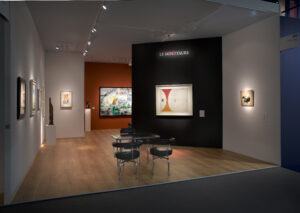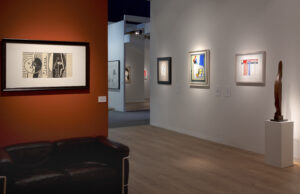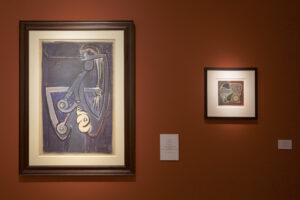PARIS + PAR ART BASEL 2023
During the 2023 edition of Paris+ by Art Basel, Le Minotaure presents a major exhibition around biomorphic art of the first half of the 20th century, form its premonitions in 1910s, its fulfillment in 1930s and its development after the Second World War, resulting in the lyrical or informal abstraction visible, for example, in manifestations of the Salon des Réalités Nouvelles.
After 1925, throughout Europe and also in the United States, we can observe the recurrence of a certain family of forms, found in every creative field, from geometric abstract art to surrealism. Irregular yet simple, they are delimited by supple curves that induce an impression of movement, suggest a possible evolution or the past transformations behind the visible result. Used in an abstract context they seem evocative, while in the field of figuration they take on a form of indeterminacy that tends towards abstraction. At once familiar and intriguing, they therefore exist in a frontier zone, an intermediary space: neither totally figurative nor totally abstract, or again having something of both registers and circulating between them. That is because their elementary character and their modes of organization, and the evocations that they elicit, are of an organic or biological nature: they stand by their connection with representations of life, both its governing principles (and growth in particular) and its smallest components (cells).
Among pioneers of this artistic phenomenon we count: Jean Arp, Juan Miro and Fernand Léger. From 1932, the Abstraction Création movement brought together a large number of artists who flirted with this kind of forms (Auguste Herbin, Frantisek Kupka, Léon Tutundjian, Jean Hélion, Etienne Béothy, Joaquin Torres -Garcia, Georges Valmier…)
The term biomorphism, used to name them, comes from the Greek words: “bios” – life, and “morphè” – form. It appeared in the art world in the mid-1930s, where it was presented as a neologism, or at least an import, serving to define the latest artistic tendency. Especially, it was used in a working version of recapitulatory diagram presenting the origins and evolution of abstract art, that Alfred Barr published for the exhibition “Cubism and Abstract Art”, he organized at the Museum of Modern Art in New York in 1936
Among masterpieces we will present during Paris+ 2023, we count in particularly the premonitory watercolors by Wassiliy Kandinsky and Fernand Léger (from his “mechanic” period), both realized in 1918. We will also show several pieces by Frantisek Kupka and Léon Tutundjian as well as a big oil painting by Roberto Matta (1957) who explored biomorphism in the context of the post-Second World War surrealism.
Moreover, on out booth you will find major works – on different media (canvases, works on paper, sculptures, photographs, etc.) – by other artists represented by our gallery such as Jean Arp, Vladimir Baranoff-Rossiné, Etienne Béothy, Augustin Cardenas, Felix Del Marle, Jindrich Styrsky, Wifredo Lam, Francis Picabia, Le Corbusier, Marcelle Cahn whose activity within movement such as constructivism, geometric abstract art, purism or surrealism, completes the image of the artistic landscape of the time.



